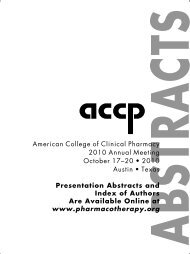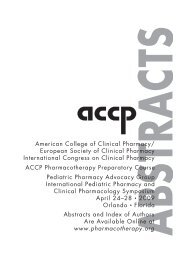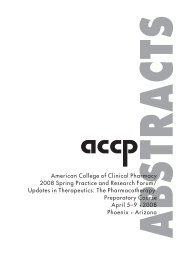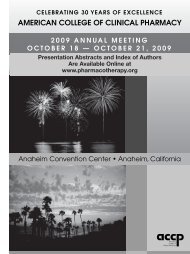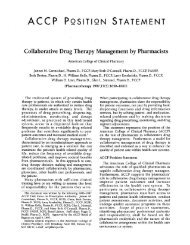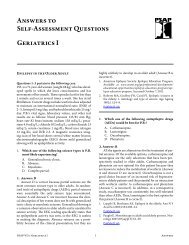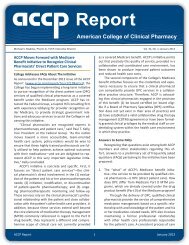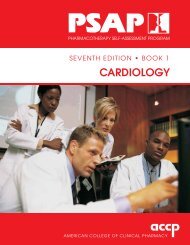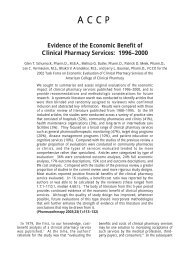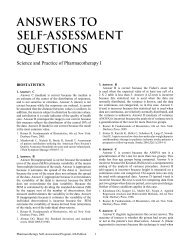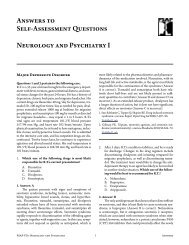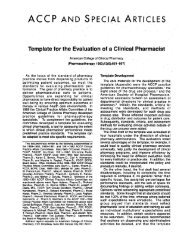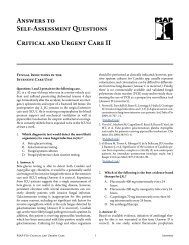Answers to Self-Assessment Questions - ACCP
Answers to Self-Assessment Questions - ACCP
Answers to Self-Assessment Questions - ACCP
Create successful ePaper yourself
Turn your PDF publications into a flip-book with our unique Google optimized e-Paper software.
claimed effect size in GAIT was an absolute increase of<br />
15% in the response rate compared with placebo, assuming<br />
a 35% response rate in the placebo group. The much larger<br />
placebo response reported in GAIT would make it more<br />
difficult <strong>to</strong> detect the effect size. Therefore, Answer D (there<br />
is minimal concern in this trial because of the successful<br />
use of a power analysis) is incorrect.<br />
1. Towheed TE, Maxwell L, Anastassiades TP, Shea B, Houpt<br />
J. Robinson V, et al. Glucosamine therapy for treating<br />
osteoarthritis. Cochrane Database Syst Rev 2005;2:CD002946.<br />
2. Guller U, DeLong E. Interpreting statistics in medical literature:<br />
a vade mecum for surgeons. J Am Coll Surg 2004;198:441–58.<br />
75. Answer: C<br />
T.G. is a 49-year-old man with hypercholesterolemia<br />
being treated with a<strong>to</strong>rvastatin. He is interested in obtaining<br />
information regarding the use of policosanol. Although early<br />
studies of Cuban sugar cane policosanol showed promising<br />
results in lipid-lowering effects, recent studies have not<br />
substantiated these results. In a double-blind, placebocontrolled<br />
trial, adding policosanol <strong>to</strong> a<strong>to</strong>rvastatin (Answer<br />
A) showed no better lipid-lowering effect than a<strong>to</strong>rvastatin<br />
alone. Other recent studies of policosanol have demonstrated<br />
that results with its use are no better than placebo in reducing<br />
low-density lipoprotein cholesterol (LDL-C). Therefore,<br />
Answer B (replacement of a<strong>to</strong>rvastatin with policosanol<br />
would result in similar lowering of LDL-C) is incorrect.<br />
The advice that policosanol should not be expected <strong>to</strong> lower<br />
LDL-C is based on its lack of efficacy (Answer C), making<br />
Answer C the correct response. Policosanol is relatively<br />
free of adverse events such as elevated liver function<br />
tests or elevated creatine phosphokinase, making Answer<br />
D (it has the potential <strong>to</strong> elevate creatine phosphokinase<br />
concentrations) incorrect.<br />
1. Cubeddu LX, Cubeddu RJ, Heimowitz T, Restrepo B,<br />
Lamas GA, Weinberg GB. Comparative lipid-lowering<br />
effects of policosanol and a<strong>to</strong>rvastatin: a randomized,<br />
parallel, double-blind, placebo-controlled trial. Am Heart J<br />
2006;152:982.e1–5.<br />
2. Berthold HK, Unverdorben S, Degenhardt R, Bulitta<br />
M, Gouni-Berhold I. Effect of policosanol on lipid values<br />
among patients with hypercholesterolemia or combined<br />
hyperlipidemia: a randomized controlled trial. JAMA<br />
2006;295:2262–9.<br />
76. Answer: D<br />
C.D. is a 32-year-old moderately obese woman who is<br />
seeking advice on the use of Saint John’s wort for postpartum<br />
depression. Although recent literature does not indicate<br />
a significant interaction between hypericum and oral<br />
contraceptives, the potential for such an interaction cannot<br />
be excluded; therefore, Answer A (current evidence fails<br />
<strong>to</strong> substantiate significant drug interactions between Saint<br />
John’s wort and oral contraceptives) is incorrect. Lovastatin<br />
undergoes similar metabolism compared with simvastatin,<br />
with CYP P450 3A4 playing a major part in its metabolism,<br />
as well as being a potential substrate for P-glycoprotein.<br />
Therefore, a significant interaction with hypericum is likely,<br />
which may result in significantly reduced bioavailability of<br />
lovastatin. Therefore, Answer B (significant interactions<br />
with Saint John’s wort and lovastatin are unlikely) is<br />
incorrect. Because C.D. is described <strong>to</strong> be suffering from<br />
major depression (i.e., postpartum depression), Answer C<br />
(recent evidence suggests benefit of hypericum extracts in<br />
patients with mild <strong>to</strong> moderate depression and is therefore a<br />
viable option for C.D.) is incorrect. Although older studies<br />
have suggested a benefit of hypericum compared with<br />
placebo for the treatment of major depression, more recent,<br />
methodologically robust studies fail <strong>to</strong> support these results.<br />
Although the consensus continues <strong>to</strong> indicate its efficacy in<br />
the treatment of symp<strong>to</strong>ms associated with mild <strong>to</strong> moderate<br />
depression, more studies are needed <strong>to</strong> further ascertain<br />
its role in the treatment of major depression. Therefore,<br />
Answer D (recent data suggest Saint John’s wort is no<br />
more efficacious than placebo for the treatment of major<br />
depression such as C.D. is experiencing) is correct because<br />
C.D. appears <strong>to</strong> meet criteria for major depression.<br />
1. Madabushi R, Frank B, Drewelow B, Derendorf H, Butterweck<br />
V. Hyperforin in St. John’s wort drug interactions. Eur J Clin<br />
Pharmacol 2006;62:225–33.<br />
2. Whitten DL, Myers P, Hawrelak A, Wolhmuth H. The effect<br />
of St. John’s wort extracts on CYP3A: a systematic review of<br />
prospective clinical trials. Br J Clin Pharmacol 2006;62:512–<br />
26.<br />
3. Hypericum Depression Trial Study Group. Effect of Hypericum<br />
perforatum (St. John’s wort) in major depressive disorder: a<br />
randomized controlled trial. JAMA 2002;287:1807–14.<br />
4. Fava M, Alpert J, Nierenberg AA, Mischoulon D, Ot<strong>to</strong> MW,<br />
Zajecka J, et al. A double-blind, randomized trial of St. John’s<br />
wort, fluoxetine, and placebo in major depressive disorder. J<br />
Clin Psychopharmacol 2005;25:441–7.<br />
77. Answer: D<br />
Equol is an isoflavone formed by bacterial intestinal<br />
metabolism of the soy isoflavone daidzein. Equol has<br />
greater affinity for the estrogen recep<strong>to</strong>r than daidzein, and<br />
activity at the estrogen recep<strong>to</strong>r is believed <strong>to</strong> be important<br />
for the activity of soy in cardioprevention and for relief of<br />
menopausal symp<strong>to</strong>ms. Only about one-third of non-Asian<br />
people can form equol from daidzein, so it is plausible<br />
that these populations may derive less benefit from soy<br />
isoflavones compared with Asian populations in which a<br />
higher percentage of the constituency are equol formers.<br />
Thus, Answer A (most Americans are equol formers) is<br />
incorrect. Although soy food supplementation has resulted<br />
in blood pressure lowering in hypertensive patients in some<br />
studies, this result has not been consistent across studies.<br />
Thus Answer B (blood pressure reduction is expected with<br />
soy isoflavones) is incorrect. The lipid-lowering effects of<br />
soy have been found <strong>to</strong> be more modest in recent studies<br />
compared with older studies. These recent effects of a 3%<br />
<strong>to</strong> 5% reduction in LDL-C are lower than those typically<br />
seen with statin agents, making Answer C (the effects are<br />
similar) an incorrect answer. The most compelling reason<br />
for incorporating more soy in<strong>to</strong> the animal protein–rich<br />
American diet is that this will tend <strong>to</strong> decrease dietary<br />
saturated fat and cholesterol (Answer D); thus Answer D is<br />
the correct answer.<br />
1. Reynolds K, Chin A, Lees KA, Nguyen A, Bujnowski D, He J.<br />
A meta-analysis of the effect of soy protein supplementation on<br />
serum lipids. Am J Cardiol 2006;98:633–40.<br />
2. Nettle<strong>to</strong>n JA, Greany KA, Thomas W, Wangen KE, Adlercreutz<br />
H, Kurzer MS. The effect of soy consumption on the urinary<br />
Pharmacotherapy <strong>Self</strong>-<strong>Assessment</strong> Program, 6th Edition 53 Gastroenterology and Nutrition <strong>Answers</strong>



